Effects of Simulated PWHT on the Microstructure and Mechanical Properties of 2.25Cr1Mo0.25V Steel for a Hydrogenation Reactor
Abstract
:1. Introduction
2. Materials and Methods
3. Results
3.1. Mechanical Properties
3.2. Microstructure Analysis
3.3. Precipitates
3.4. Element Distribution
3.5. Fracture Morphology of High-Temperature Tensile Samples
3.6. Cavity Nucleation in High-Temperature Tensile Samples
3.7. Precipitates in the Microstructure of High-Temperature Tensile Samples
4. Discussion
5. Conclusions
- (1)
- An increase in the SPWHT time decreased the toughness, hardness, and strength of the steel. After Min.SPWHT, the high-temperature tensile strength decreased significantly more, and the damage of the Min.SPWHT to the high-temperature tensile strength of the steel plate reached approximately 80% of the Max.SPWHT.
- (2)
- The microstructure of the tested steel before and after SPWHT consisted of granular bainite and lath bainite, without appreciable changes in grain size. After SPWHT, the amount of lath bainite decreased with an increase in the amount of granular bainite; the lath of bainite widened; the intergranular carbides precipitated as coarse carbides, carbide clusters, and chains of carbides; alloy element segregation occurred, and the segregation of Mo was the most serious, followed by Cr, V.
- (3)
- The precipitation behaviors of carbides and the increase in the effective grain size caused by the widening of bainite–ferrite lath worked together and resulted in the decline of the impact toughness after Max.SPWHT. During SPWHT, the segregation of Cr and Mo greatly weakened the effect of the solid solution strengthening; the coarsening of precipitates resulted in a reduction in precipitation strengthening. The segregation of solid solution elements and the coarsening of carbides and carbides clusters were the main factors in the strength reduction in the tested steel.
- (4)
- In the high-temperature tensile test, the defects first appeared around the coarse carbides and carbide clusters. Controlling the size of the intergranular large-size carbides and the degree of cluster precipitation in the NT state structure may be a means of obtaining a higher strength of the base metal subjected to PWHT.
Author Contributions
Funding
Data Availability Statement
Conflicts of Interest
References
- Zhenrong, Z.; Wenhui, Z.; Qingchun, L. Development history of hydrogenated reactor. CFHI Technol. 2004, 1–3. [Google Scholar] [CrossRef]
- Chu, L.; Chen, X.; Fan, Z. Characterization of heterogeneous creep deformation in vanadium-modified 2.25Cr1Mo steel weldments by digital image correlation. Mater. Sci. Eng. 2021, 816, 141350. [Google Scholar] [CrossRef]
- Niu, H. Development of welding process for 2.25Cr1Mo0.25V steel in hydrogenation reactor. Equip. Maint. Technol. 2019, 3, 202. [Google Scholar] [CrossRef]
- Zhou, S. Low Alloy Heat-Resistant Steel; Shanghai People’s Publishing House: Shanghai, China, 1976. [Google Scholar]
- Fu, R.D.; Wang, T.S.; Zhou, W.H.; Zhang, W.H.; Zhang, F.C. Characterization of precipitates in a 2.25Cr–1Mo–0.25V steel for large-scale cast-forged products. Mater Charact 2007, 56, 968–973. [Google Scholar] [CrossRef]
- Masuyama, F. Advances in physical metallurgy and processing of steels: History of power plants and progress in heat resistant steels. ISIJ Int. 2001, 41, 612–625. [Google Scholar] [CrossRef]
- Hannah, S.; Christian, F.; Ronny, K. On the impact of post weld heat treatment on the microstructure and mechanical properties of creep resistant 2.25Cr-1Mo-0.25V weld metal. J. Mater. Sci. 2021, 56, 20208–20223. [Google Scholar] [CrossRef]
- Hu, X.; Zhang, H.; Sui, S. Effect of simulated post-weld heat treatment on microstructure and properties of 316 H steel. Press. Vessel. Technol. 2022, 39, 34–39. [Google Scholar] [CrossRef]
- Wu, Y.; Wen, B.; Niu, H.; Zhang, M. The Effect of Simulated Post Welding Heat Treatment on the Properties of 12Cr2MolR Steel Plate in Hydrogen Environment. Wide Heavy Plate 2012, 18, 5–8. [Google Scholar] [CrossRef]
- Lee, S.; Kim, B.C.; Kwon, D. Correlation of microstructure and fracture properties in weld heat- affected zones of thermomechanically controlled processed steels. Metall. Trans. A 1992, 23, 2803–2816. [Google Scholar] [CrossRef]
- Sui, Z.; Chen, B.; Wang, H. Investigation on Simulated PWHT of SA516Gr70 Steel for Low and Moderate Temperature Pressure Vessel. Wide Heavy Plate 2012, 18, 5–8. [Google Scholar] [CrossRef]
- BPV Committee. ASME Boiler & Pressure Vessel Code, Section Ⅱ MATERIALS, Part A, Ferrous Material Specifications; American Society for Testing and Materials: New York, NY, USA, 2013. [Google Scholar]
- Yan, B. Analysis of simulated post weld heat treatment process. Metall. Smelt. 2020, 11, 24–25. [Google Scholar]
- Xu, W.; Yu, X.; Zhou, P. Research of PWHT of 13MnNiMoR Steel Plate. Spec. Steel Technol. 2020, 26, 51–53. [Google Scholar] [CrossRef]
- Wang, Y.; Sun, D.; Wang, C. Effect of Simulated Post-Welded Heat Treatment on Microstructure and Impact Properties of SA-738Gr.B Steel Plate. Press. Vessel. Technol. 2014, 10–14. [Google Scholar] [CrossRef]
- Kromm, A.; Lausch, T.; Schroepfer, D. Influence of welding stresses on relief cracking during heat treatment of a creep-resistant 13CrMoV steel Part II: Mechanisms of stress relief cracking during post weld heat treatment. Weld. World 2021, 65, 2251. [Google Scholar] [CrossRef]
- Mei, L.; Wei, G. Fabrication of Hydrotreating Reactor Made of 2.25Cr-1Mo-0.25V Steel. Press. Vessel. Technol. 2003, 20, 36–42. [Google Scholar] [CrossRef]
- Hu, X.; Wang, C.; Zhang, J. Development of 12Cr2Mo1 VR(H) Steel Plate for Equipment under Hydrogen Atmosphere. Press. Vessel. Technol. 2017, 34, 75–80. [Google Scholar] [CrossRef]
- Qin, M.; Cheng, G.; Li, Q. Study of influence factors on quality of 2.25Cr-1Mo-0.25V steel for welded joint of hydrogenation reactor. Press. Vessel Technol. 2022, 39, 9–18. [Google Scholar] [CrossRef]
- Hou, J.; Li, Z.; Wu, Y. Research and Development of 12Cr2Mo1VR Steel Plate Rolled from ESR Ingot in Wusteel. Wide Heavy Plate 2018, 24, 16–20. [Google Scholar] [CrossRef]
- Zhao, G.; Hu, Z.; Hou, J. Effect of Heat Treatment Process on Tensile Strength of 12Cr2Mo1VR Steel Plate. Wide Heavy Plate 2017, 23, 1–4. [Google Scholar] [CrossRef]
- Titova, T.I.; Shulgan, N.A.; Borovskoy, A.S. Study of the structural state of the metal welded joint 2.25Cr-1Mo-V steel depending on the parameters of post-weld heat treatment. IOP Conf. Ser. Mater. Sci. Eng. 2020, 826, 012016. [Google Scholar] [CrossRef]
- Sirohi, S.; Sauraw, A.; Kumar, A.; Kumar, S.; Rajasekaran, T.; Kumar, P.; Vidyarthy, R.S.; Kumar, N.; Pandey, C. Characterization of Microstructure and Mechanical Properties of Cr-Mo Grade P22/P91 Steel Dissimilar Welds for Supercritical Power Plant Application. J. Materi. Eng. Perform. 2022, 31, 7353–7367. [Google Scholar] [CrossRef]
- Yang, X.; Yan, X.; Hou, J. Research and Development of 12Cr2Mo1VR Steel Plate for High Pressure Hot Separator. Wide Heavy Plate 2020, 26, 1–5. [Google Scholar]
- Lu, J. Thermodynamics Calculation and Structure Properties Resrarch of Heat-Resistant Steel GX12. Master, Thesis, Harbin University of Science and Technology, Harbin, China, 2009. [Google Scholar]
- Li, L.; Jin, G.; Zheng, W. Comparative Study on Temper brittleness of 12Cr2Mo1 and 12Cr1MoV Steel. Mech. Eng. 2003, 5, 31–33. [Google Scholar] [CrossRef]
- Han, Y. Study on the Mechanism of Reheat Cracking in 2.25Crl Mo0.25V Steel. Ph.D. Thesis, University of Science and Technology of China, Hefei, China, 2015. [Google Scholar]
- Asahi, H.; Hirakami, D.; Yamasaki, S. Hydrogen Trapping Behavior in Vanadium-added Steel. Trans. Iron Steel Inst. Jpn. 2003, 43, 527–533. [Google Scholar] [CrossRef] [Green Version]
- He, M.; Onwudinanti, C.; Zheng, Y. Ab initio study of metal carbide hydrides in the 2.25Cr1Mo0.25V steel. Phys. Chem. Chem. Phys. 2021, 23, 5199–5206. [Google Scholar] [CrossRef]
- Zhang, Y.; Miao, L.; Wang, X. Evolution Behavior of Carbides in 2.25Cr-1Mo-0.25V Steel. Mater. Trans. 2009, 50, 2507–2511. [Google Scholar] [CrossRef] [Green Version]
- Jiang, Z.; Wang, P.; Li, D. Effects of tempering temperature on the microstructure and mechanical properties of granular bainite in 2.25Cr-1Mo-0.25V steel. Acta Metall. Sin. 2015, 51, 925–934. [Google Scholar] [CrossRef]
- Jiang, Z.; Wang, P.; Li, D. Influence of the decomposition behavior of retained austenite during tempering on the mechanical properties of 2.25Cr-1Mo-0.25 V steel. Mater. Sci. Eng. 2019, 742, 540–552. [Google Scholar] [CrossRef]
- Mohyla, P.; Foldyna, V. Improvement of reliability and creep resistance in advanced low-alloy steels. Mater. Sci. Eng. A 2009, 510, 234–237. [Google Scholar] [CrossRef]
- Abe, F. Progress in Creep-Resistant Steels for High Efficiency Coal-Fired Power Plants. J. Press. Vessel. Technol. 2016, 138, 040804-1-21. [Google Scholar] [CrossRef]
- Zhang, X. Atomistic simulations of solid solution strengthening in Ni-based superalloy. Comput. Mater. Sci. 2013, 68, 132–137. [Google Scholar] [CrossRef]
- Chen, J. Study on the Microstructure and Mechanical Properties of 12Cr2Mo1R Steel for Reactor Internals in HTR-PM. Ph.D. Thesis, Shanghai Jiao Tong University, Shanghai, China, 2015. [Google Scholar]
- Shi, R.; Yang, R.; Li, J. Analysis of valence electron structures(VES) of strenghening effects of chromium and molybdenum on 12Cr1MoV steel matrix. Mater. Mech. Eng. 2003, 27, 10–12. [Google Scholar] [CrossRef]
- Shi, R.; Yang, R.; Yin, Y. Electron Theory Analysis of Alloying Elements Impoverishment in 12CrlMoV. J. Mater. Sci. Eng. 2003, 84, 550–553. [Google Scholar] [CrossRef]
- Zhao, Y.; Wu, Y.; Liu, H.; Zhang, P. Effects of Simulated Post Welding Heat Treatment on Microstructure and Mechanical Properties of 14Cr1MoR Steel. In Proceedings of the 10th CSM Steel Congress & the 6th Baosteel Biennial Academic Conference, Shanghai, China, 21–23 October 2015. [Google Scholar]
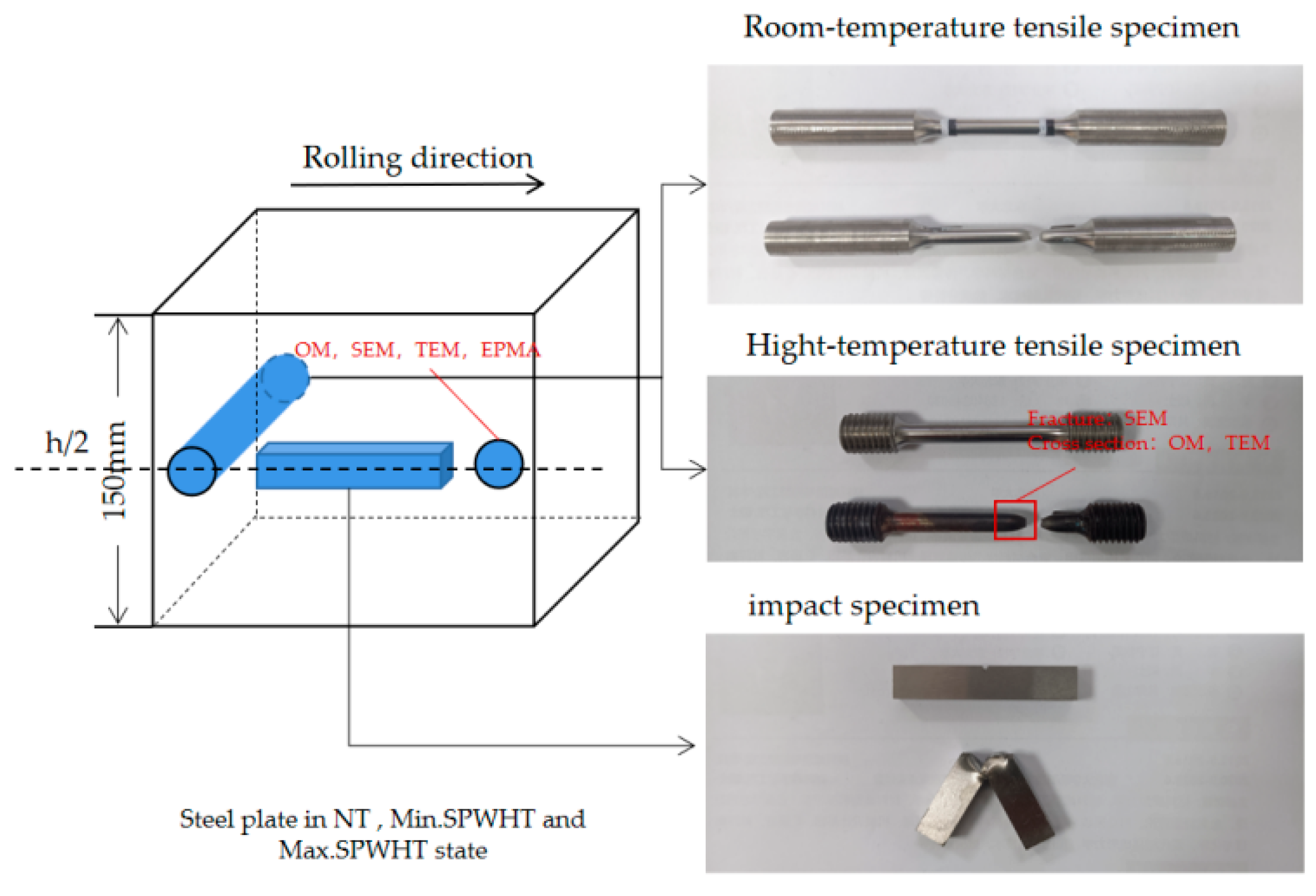
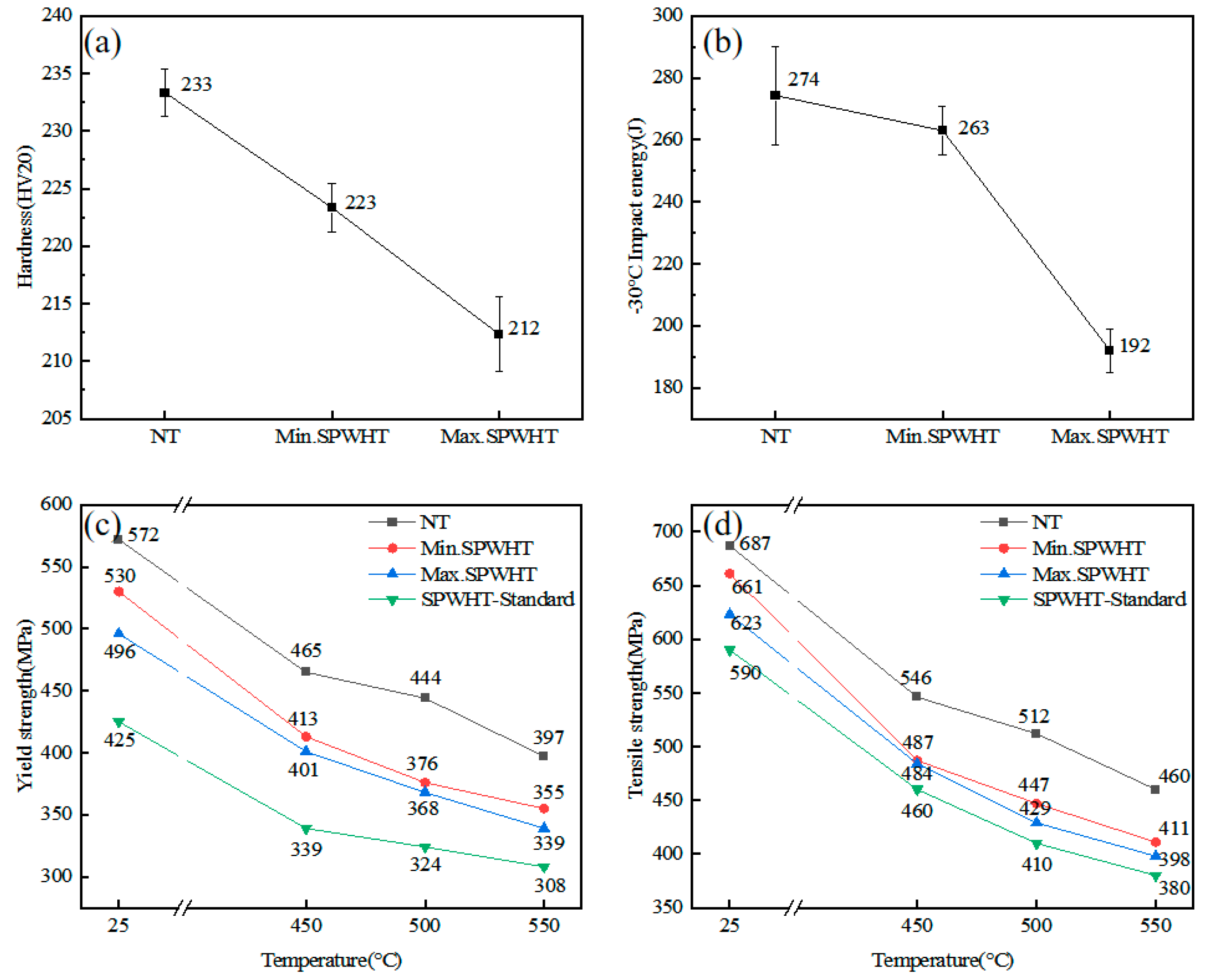

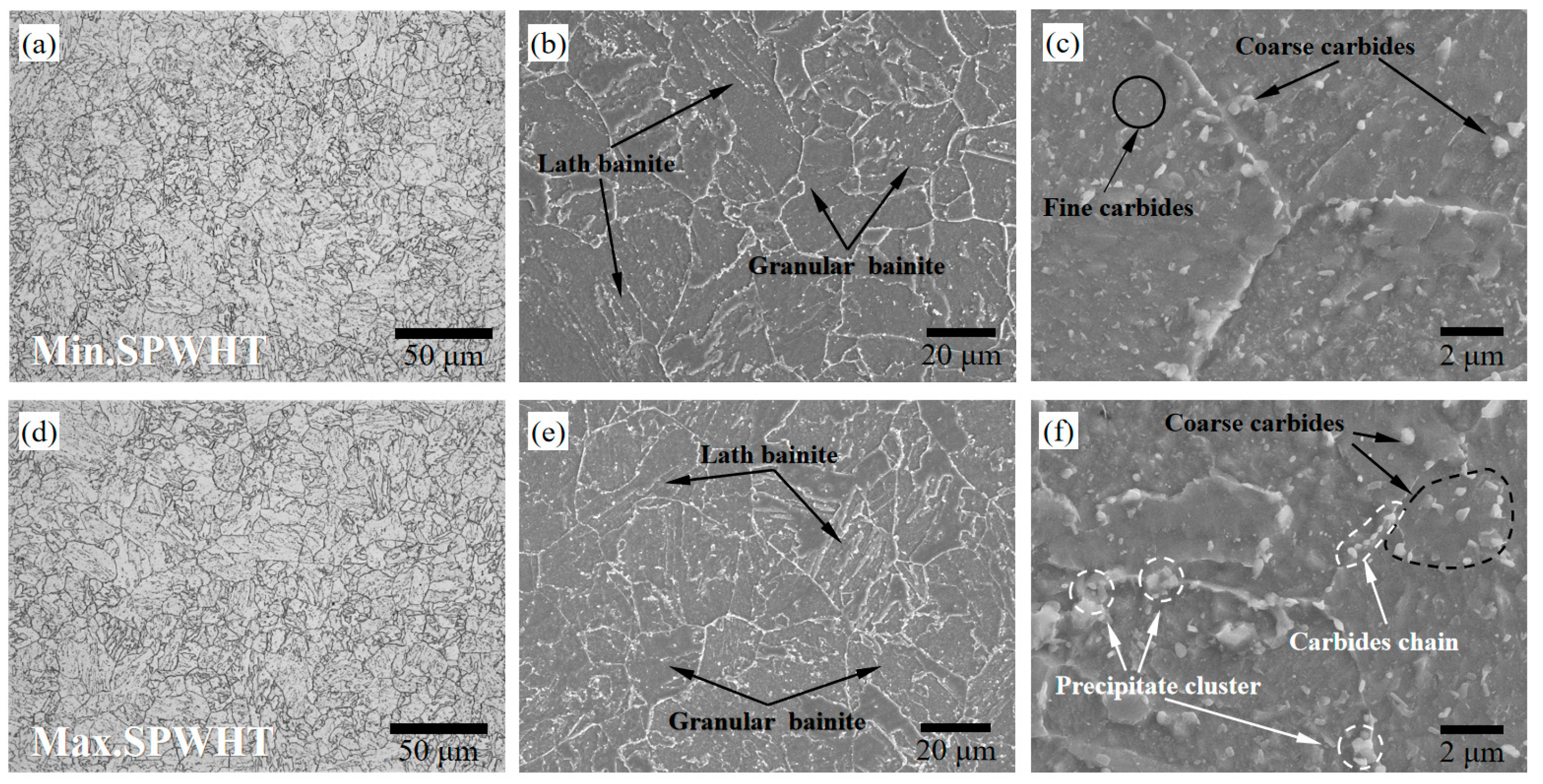
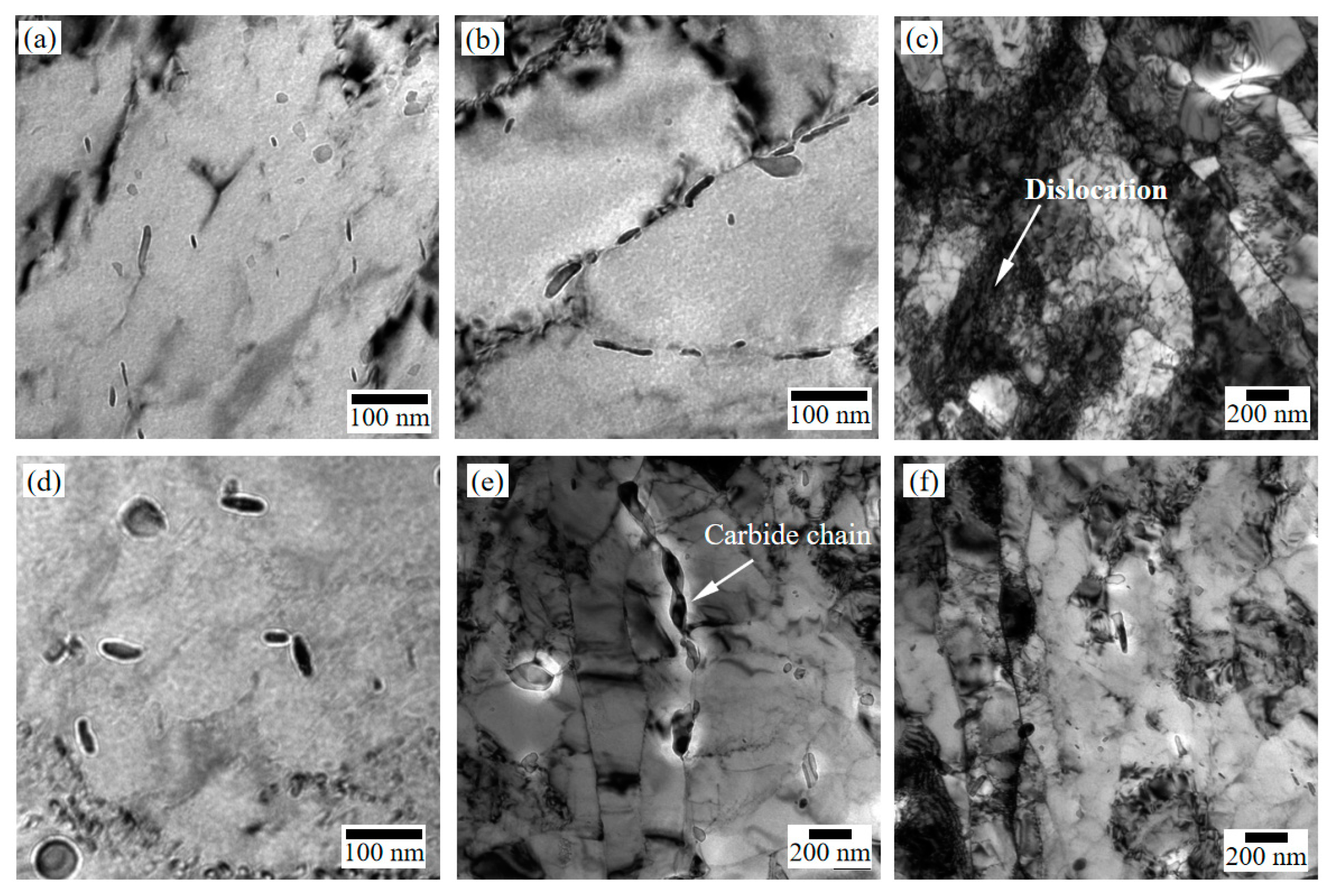

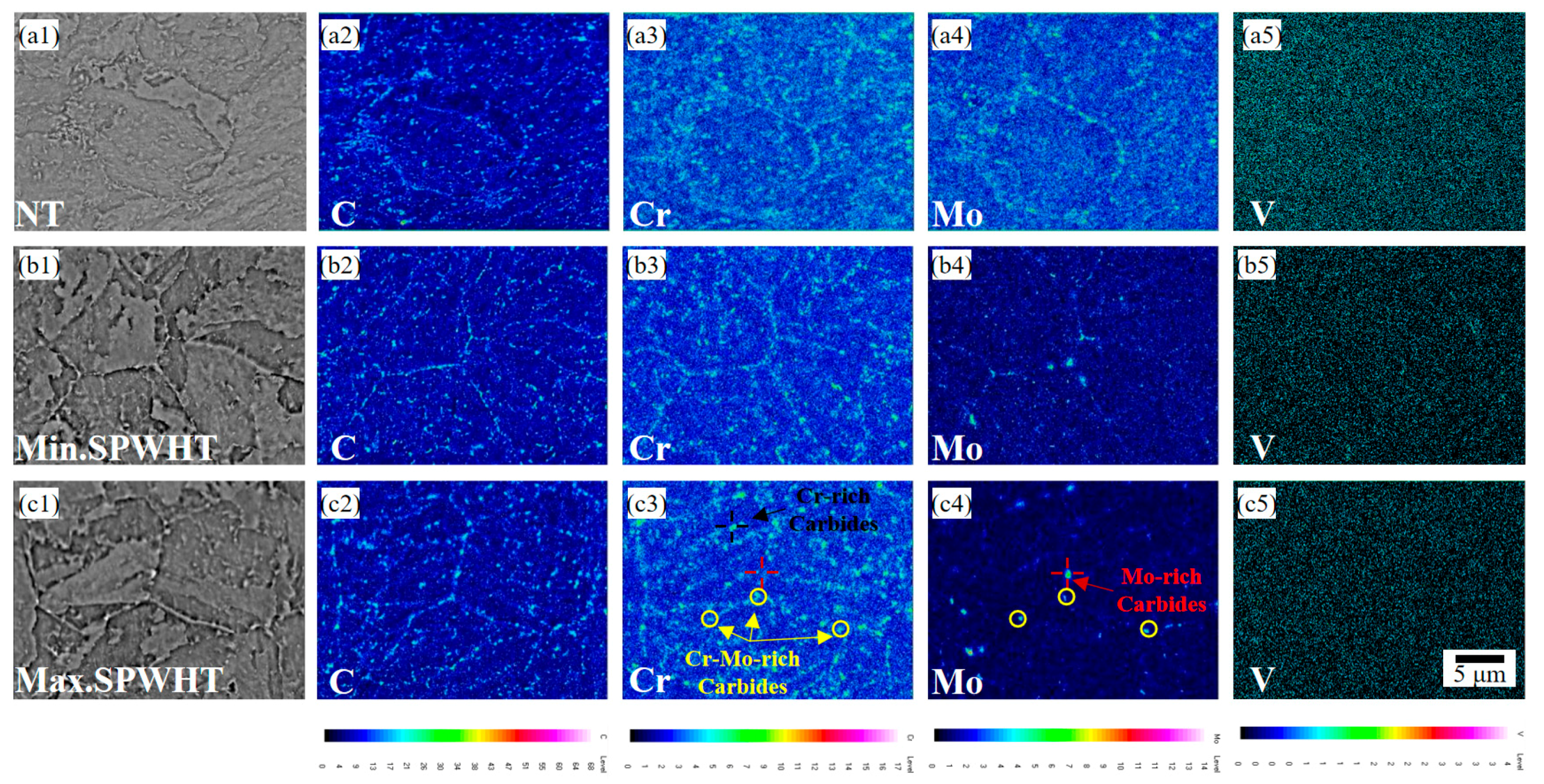


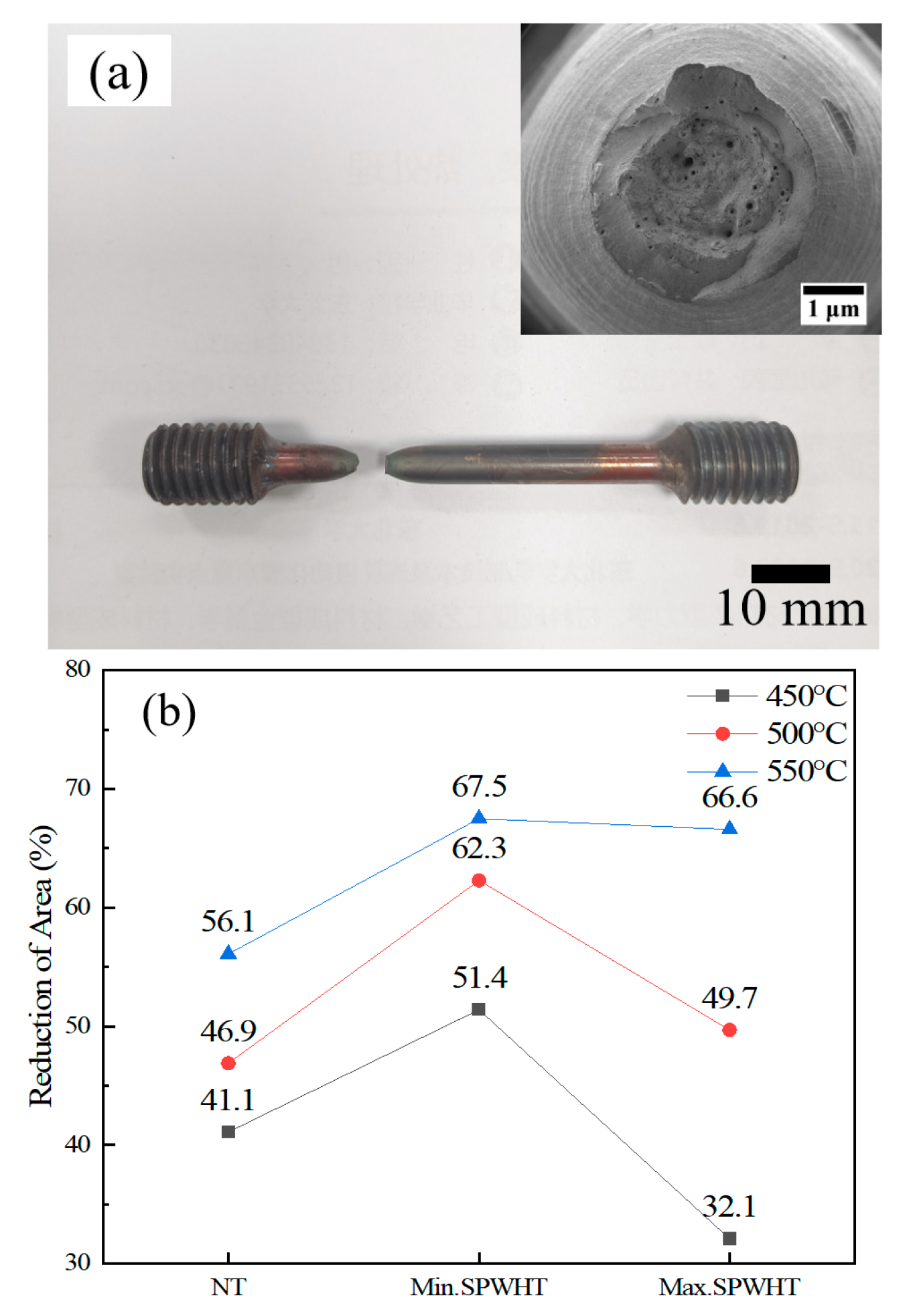
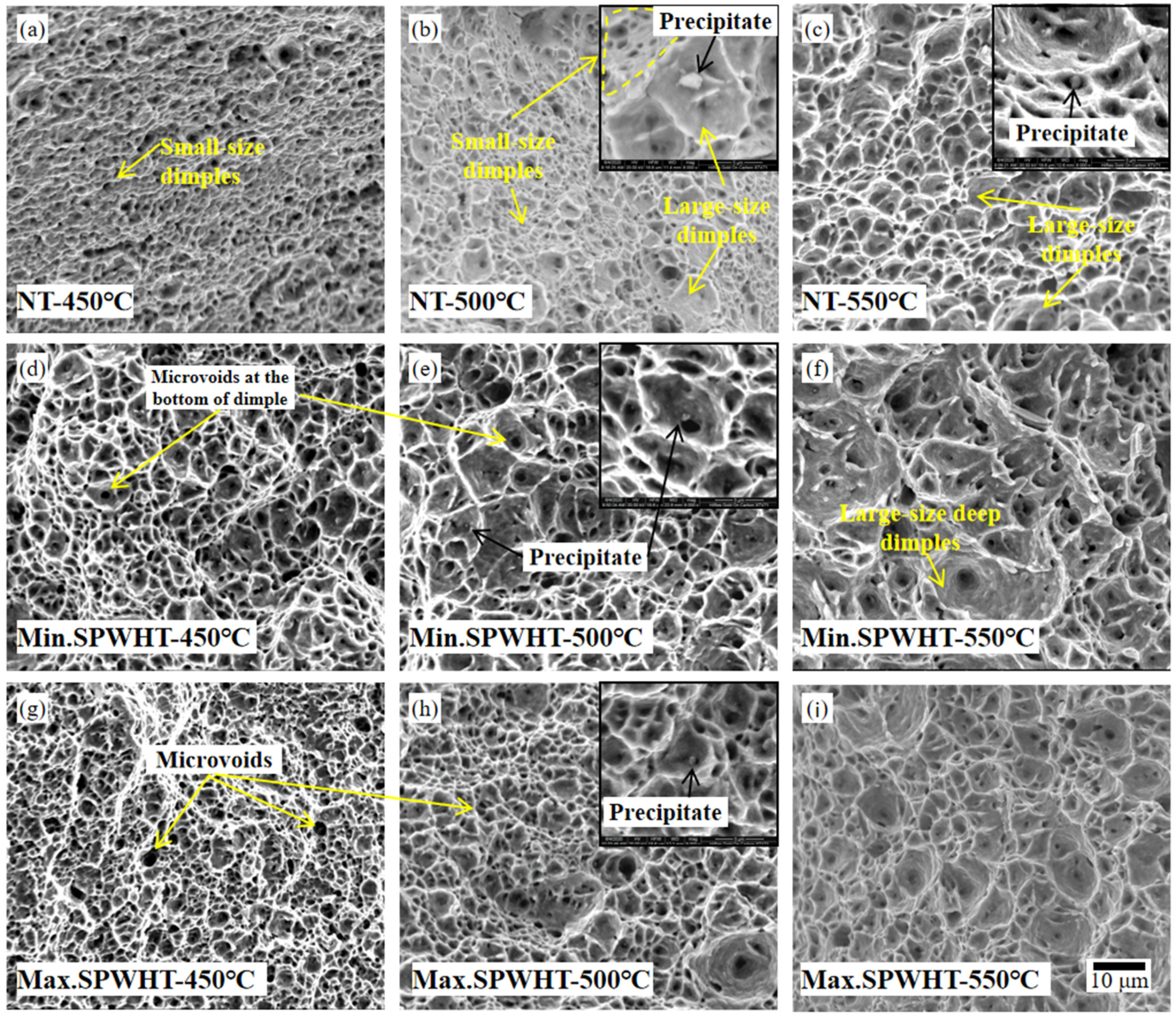

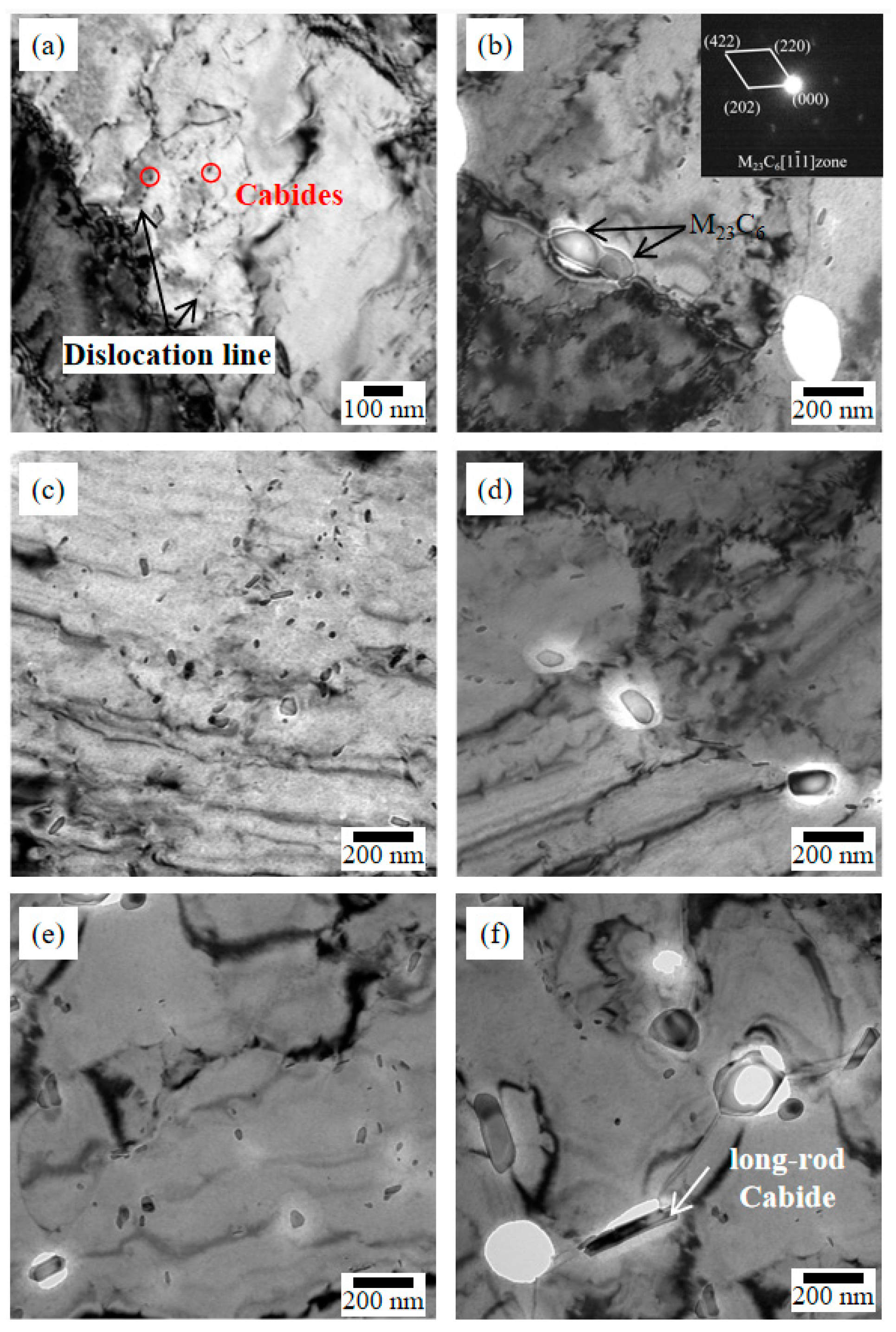
| Element | C | Si | Mn | Cr | Ni | Mo | B | V | Ti | Fe |
|---|---|---|---|---|---|---|---|---|---|---|
| value | 0.14 | 0.10 | 0.50 | 2.31 | 0.15 | 1.00 | 0.002 | 0.25 | 0.02 | bal |
| Hardness/HV20 | −30 °C Impact Energy/J | ReL/MPa | Rm/MPa | ||
|---|---|---|---|---|---|
| NT | 231, 235, 234 | 257, 288, 278 | 25 °C | 572 | 687 |
| 450 °C | 465 | 546 | |||
| 500 °C | 444 | 512 | |||
| 550 °C | 397 | 460 | |||
| Standard | ≤235 HV | ≥54 J | 25 °C | 425–620 | 590–760 |
| 450–500 °C | ≥350 | - |
Publisher’s Note: MDPI stays neutral with regard to jurisdictional claims in published maps and institutional affiliations. |
© 2022 by the authors. Licensee MDPI, Basel, Switzerland. This article is an open access article distributed under the terms and conditions of the Creative Commons Attribution (CC BY) license (https://creativecommons.org/licenses/by/4.0/).
Share and Cite
Li, Y.; Cui, Y.; Zhang, J.; Song, M.; Xu, C. Effects of Simulated PWHT on the Microstructure and Mechanical Properties of 2.25Cr1Mo0.25V Steel for a Hydrogenation Reactor. Metals 2022, 12, 1978. https://doi.org/10.3390/met12111978
Li Y, Cui Y, Zhang J, Song M, Xu C. Effects of Simulated PWHT on the Microstructure and Mechanical Properties of 2.25Cr1Mo0.25V Steel for a Hydrogenation Reactor. Metals. 2022; 12(11):1978. https://doi.org/10.3390/met12111978
Chicago/Turabian StyleLi, Yanmei, Yonghao Cui, Jimou Zhang, Minghui Song, and Chen Xu. 2022. "Effects of Simulated PWHT on the Microstructure and Mechanical Properties of 2.25Cr1Mo0.25V Steel for a Hydrogenation Reactor" Metals 12, no. 11: 1978. https://doi.org/10.3390/met12111978





